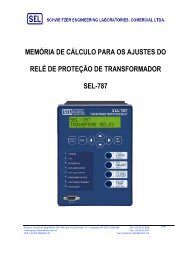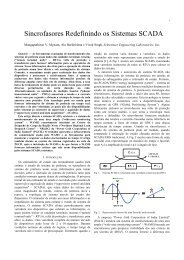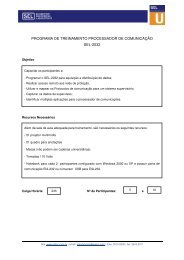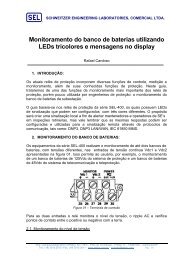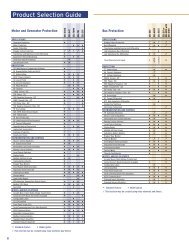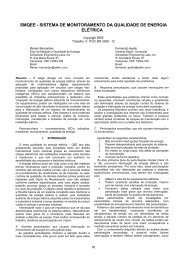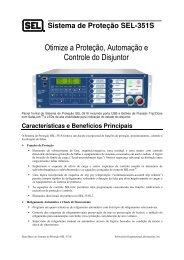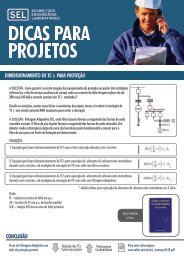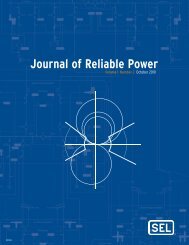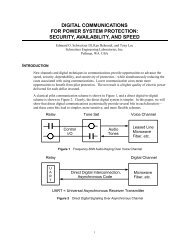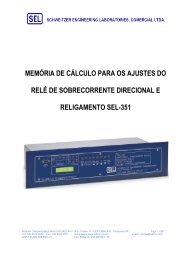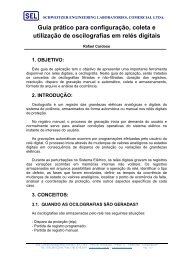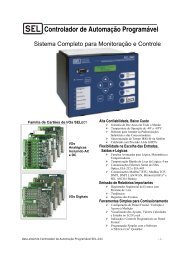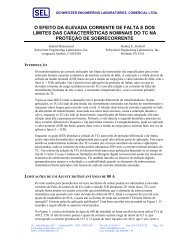Journal of Reliable Power - SEL
Journal of Reliable Power - SEL
Journal of Reliable Power - SEL
Create successful ePaper yourself
Turn your PDF publications into a flip-book with our unique Google optimized e-Paper software.
Capable <strong>of</strong> running protection calculations with latencies<br />
low enough for line protection, microprocessor-based<br />
relays allowed designers to take full advantage <strong>of</strong> the flexibility<br />
<strong>of</strong> digital implementations. Building protection elements<br />
by calculating signature signals and freely applying<br />
comparators, logic, and timers, designers were no longer<br />
constrained by analog means; they could truly innovate<br />
by going back to first principles and using these principles<br />
to devise new and powerful protection elements. Positivesequence<br />
voltage memory to maintain distance element<br />
security during close-in faults, advancements in digital filtering,<br />
a negative-sequence impedance ground directional<br />
element, load-encroachment logic, and fault identification<br />
selection logic are among the many innovations introduced<br />
in the early 1990s as part <strong>of</strong> the <strong>SEL</strong>-321 Relay.<br />
Ability to communicate was an inherent advantage<br />
<strong>of</strong> microprocessor-based relays from the very beginning.<br />
Communication started with users accessing and manipulating<br />
settings, records, and online measurements but<br />
quickly progressed into serving data to SCADA systems<br />
and peer-to-peer devices. Invention <strong>of</strong> Mirrored Bits ®<br />
communications—fast, reliable, and dependable protection-grade<br />
communications—opened a new chapter <strong>of</strong><br />
digital teleprotection signaling for line protection. (See<br />
“Digital Communications for <strong>Power</strong> System Protection:<br />
Security, Availability, and Speed” in this issue.)<br />
The last decade brought considerable advances in<br />
distance protection. Higher sampling rates and increased<br />
processing power opened the door to sophisticated protection<br />
principles and enhancements. Improvements in security<br />
and speed <strong>of</strong> distance protection have been achieved<br />
through a combination <strong>of</strong> CVT transient detection under<br />
high SIR conditions and usage <strong>of</strong> incremental quantities<br />
while applying optimized, faster, short-window filters.<br />
Fault type identification logic now performs better under<br />
weak infeed conditions. Adaptive polarizing algorithms<br />
maintain the best possible choice <strong>of</strong> polarization while<br />
releasing the user from making trade<strong>of</strong>fs and running<br />
detailed engineering studies to aid setting selection. Protection<br />
issues related to series compensation <strong>of</strong> transmission<br />
lines have been addressed as well. Frequency tracking<br />
<strong>of</strong> modern relays allows applications under stressed<br />
system conditions when frequency excursions and rate <strong>of</strong><br />
change <strong>of</strong> frequency jeopardize some traditional concepts,<br />
such as memory polarization. “Transmission Line Protection<br />
System for Increasing <strong>Power</strong> System Requirements”<br />
gives an excellent overview <strong>of</strong> these advancements.<br />
The <strong>SEL</strong>-421 Protection, Automation, and Control<br />
System, developed in 2001, incorporates all <strong>of</strong> these<br />
enhancements while including a truly impressive set <strong>of</strong><br />
functions that complement its core protection functionality.<br />
Examples are high-resolution digital fault recording,<br />
sequential events recording, and synchrophasor measurements,<br />
all with submicrosecond accuracy, a wealth <strong>of</strong><br />
both peer-to-peer and SCADA communications protocols,<br />
metering functions, advanced programmable protection<br />
and automation logic, two CT sets <strong>of</strong> inputs for dualbreaker<br />
line terminals with associated protection, and<br />
automation functions. These are functions that we all take<br />
for granted today.<br />
Looking back, the ability to provide data for postevent<br />
analysis turned out to be one <strong>of</strong> the major benefits<br />
<strong>of</strong> microprocessor-based relays. “Lessons Learned Analyzing<br />
Transmission Line Faults” provides an overview <strong>of</strong><br />
how data produced by modern relays aid troubleshooting<br />
and improve our understanding <strong>of</strong> the power system.<br />
Innovations in line protection are ongoing. Examples<br />
include improved power swing detection based on the rate<br />
<strong>of</strong> change <strong>of</strong> the swing center voltage and better resistive<br />
coverage <strong>of</strong> distance functions through an adaptive quadrilateral<br />
characteristic. (See “Adaptive Phase and Ground<br />
Quadrilateral Distance Elements” in this issue.)<br />
The journey that started a quarter <strong>of</strong> a century ago<br />
continues. Today, we use precise timing to align and timetag<br />
measurements. We use high-speed communications<br />
to share data in real time to improve protection and automation<br />
functions. And, we use more powerful processors<br />
to efficiently run increasingly more sophisticated algorithms.<br />
The opportunity that technology created 25 years<br />
ago is still here. It is only the laws <strong>of</strong> physics and our own<br />
imaginations that bound us today.<br />
If you have comments or suggestions, please e-mail<br />
journal@selinc.com or share your thoughts with our editors<br />
by phone at +1.509.332.1890.<br />
Introduction | 3



